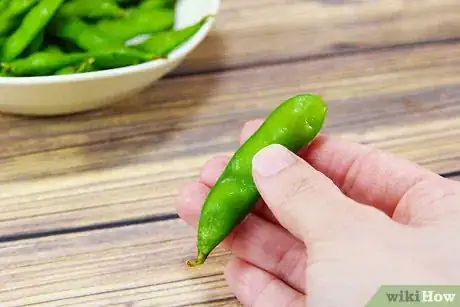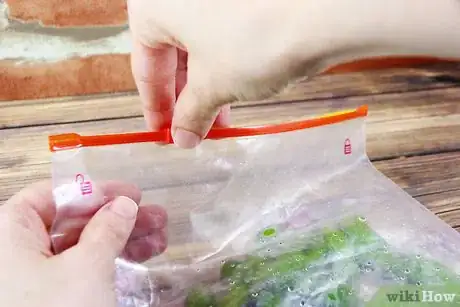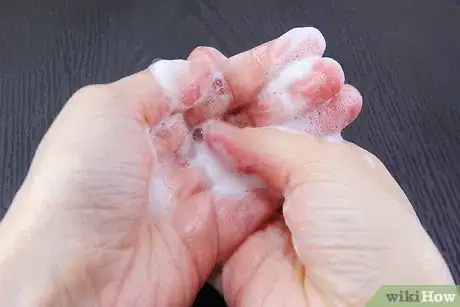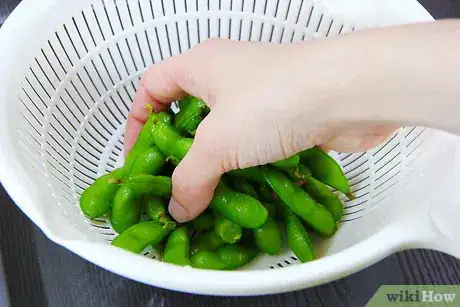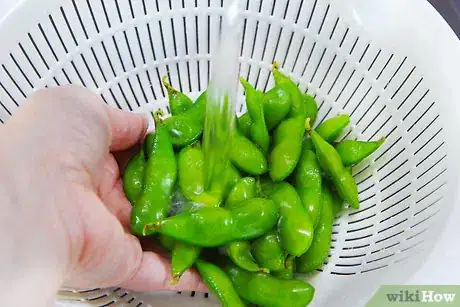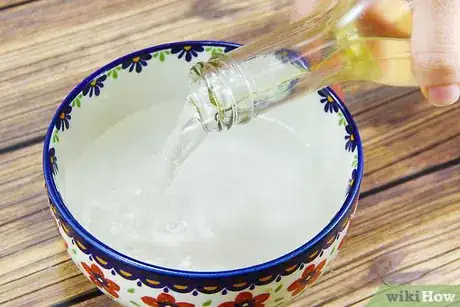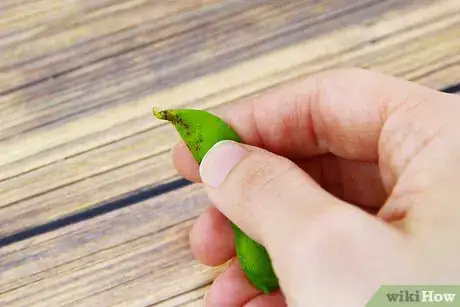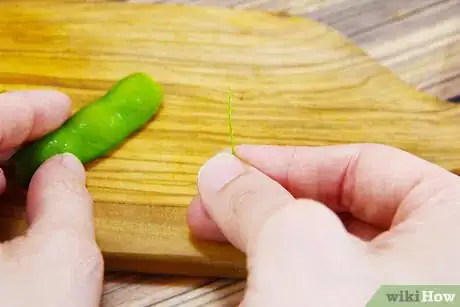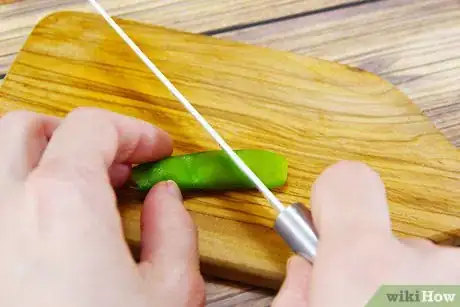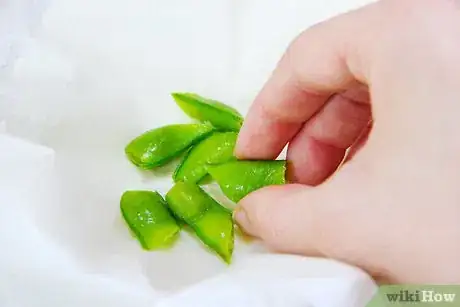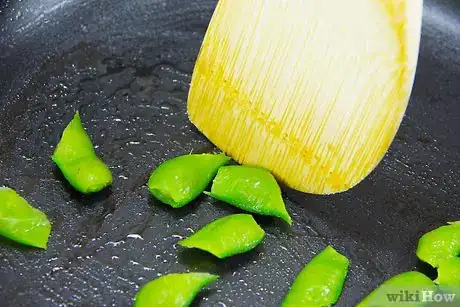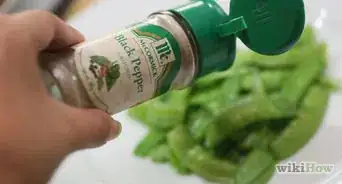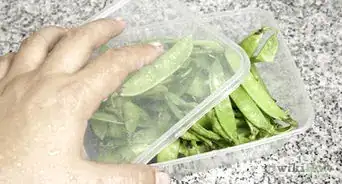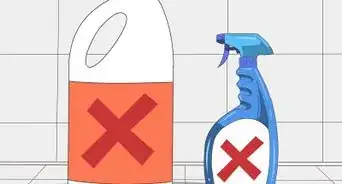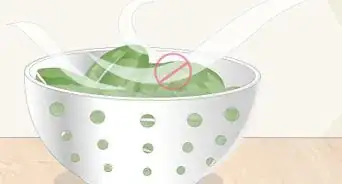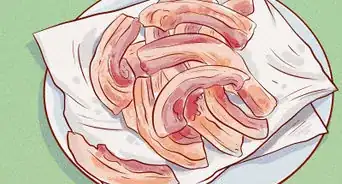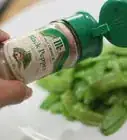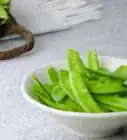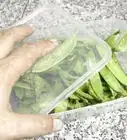This article was co-authored by wikiHow Staff. Our trained team of editors and researchers validate articles for accuracy and comprehensiveness. wikiHow's Content Management Team carefully monitors the work from our editorial staff to ensure that each article is backed by trusted research and meets our high quality standards.
There are 7 references cited in this article, which can be found at the bottom of the page.
This article has been viewed 20,423 times.
Learn more...
Snow peas, also called Chinese pea pods, are used in a wide variety of dishes. You can either cook them or eat them raw. To properly clean your snow peas, start by washing them off under cold water. Remove any pods that are blemished or damaged. Cut off the tips with a sharp knife and remove the side strings. Wash once more, if desired.[1]
Steps
Completing an Initial Rinse
-
1Choose healthy peas. A mature snow pea can be up to 3 inches in length. Select ones with smooth, not wrinkly, skin. They should have a solid green skin free of any cracks. The pods should be fairly flat, indicating small sized peas. If the peas are too big, the pod is overgrown and will be tough in texture.[2]
- A tiny petal at the stem of the pod is a sign that it is fresh and ready to be eaten or stored.[3]
-
2Store them for limited periods. Once you’ve bought or harvested your pods, they can be stored in a sealed plastic bag for a maximum of three days. They will need to be refrigerated to preserve freshness during this time. Be wary of extending the storage period beyond just a few days as it will impact the taste of the pods.[4]Advertisement
-
3Wash your hands. Before you start to handle your produce, go ahead and rinse your hands off under some warm water. Use soap as well to ensure maximum cleanliness. Dry off your hands. Repeat handwashing as often as desired.
-
4Place the pods in a strainer. Empty your pods into a strainer or colander. Make sure that there is enough space for the pods to fully fit without falling out or spilling over. Depending on the size of the colander and the number of pods, you may need to repeat this step multiple times.
-
5Rinse them under water. Hold the colander under cool water. Use your extra hand to stir to pea pods to ensure that they all get washed thoroughly. If one pod looks particularly dirty, pick it out with your hands and lightly scrub it with your fingers.[5]
-
6Wash them in a vinegar solution. You can also get a bowl and mix together a 90% vinegar 10% water solution inside. Place the pea pods into the bowl and let them soak for 15-20 minutes. This should remove any remaining pesticide residue. However, be aware that keeping the pods in the solution between the specified time can damage the skin and impact the texture.[6]
- Washing your pods in a 2% salt water mixture can also provide a deeper clean.
Trimming the Pods for Use
-
1Check for any damage or blemishes. After you finish washing the pods, look them over to see if there are any yellow spots on the skin. Remove and discard those pods with spots or cuts. It is possible to trim away the impacted portion of the pod with a sharp knife, but the peas inside may be damaged.[7]
-
2Trim the ends. Remove the peas from the colander one-by-one and place them on a cutting board. Using a paring knife, trim away both ends of the pod. Don’t trim too far into the pod itself, just cut away the hard ends.[8]
-
3Remove the string. Once the ends are removed, you will see a string running the length of the pod. Use your fingers to pull this string out or pin the string against your knife blade and tug it out that way. Dispose of the string.[9]
-
4Thinly slice. If you prefer, set the trimmed pea pod back onto the cutting board and use your paring knife to cut the pod diagonally into equally sized slices. You can also skip this step and leave the pod intact.[10]
Cooking or Storing the Pods
-
1Dry them thoroughly. If you plan to store your pods, it is especially important to remove all moisture from their skin. Lay them out on a towel and lightly press another fresh towel on top of them. Or, pick up a handful of pods at a time and rub them with a towel. This will prevent ice crystals from forming in the colder temperatures of the refrigerator.[11]
-
2Cook or store as preferred. If you decide to cook your snow peas, you will want to do so right away. It only takes 1-2 minutes to cook the peas via a steam or stir-fry method. If you choose to store the pods, then they will keep in the fridge for up to 4 days.[12]
-
3Eat them raw. Be aware that you can also eat snow peas raw directly after cleaning. This guarantees the best flavor. You will notice that the fresh peas have a firm, crunchy texture.[13]
Warnings
- Follow safe food preparation guidelines and keep washed snow peas separate from unwashed products.⧼thumbs_response⧽
Things You’ll Need
- Snow pea pods
- Water
- Vinegar
- Strainer or colander
- Towel
- Cutting board
- Paring knife
References
- ↑ http://www.thekitchn.com/whats-the-difference-between-snow-peas-sugar-snap-peas-and-english-peas-ingredient-intelligence-205118
- ↑ http://www.harvesttotable.com/2007/04/snow_peas_you_can/
- ↑ http://startcooking.com/how-to-cook-with-snow-peas
- ↑ http://www.harvesttotable.com/2007/04/snow_peas_you_can/
- ↑ http://startcooking.com/how-to-cook-with-snow-peas
- ↑ http://www.healthyandnaturalworld.com/easily-remove-pesticides-fruits-vegetables/
- ↑ http://www.recipetips.com/kitchen-tips/t--1141/all-about-peas.asp
- ↑ https://www.taste.com.au/quick-easy/articles/how-to-prepare-snow-peas/66DqinSP
- ↑ http://startcooking.com/how-to-cook-with-snow-peas
